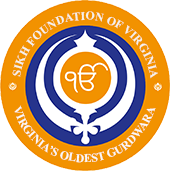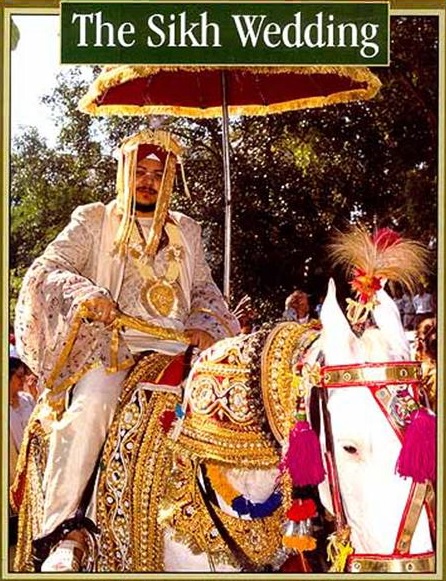Anand Karaj is performed in the presence of Sikh Holy Book, Guru Granth Sahib. Guru Granth Sahib is revered as a living Guru by the Sikhs. As a mark of respect, everyone covers their head and removes their shoes when one is in presence of the Guru, Guru Granth Sahib. In a Sikh Temple (Gurdwara) Guru Granth Sahib is displayed under a canopy (chandoa) in the main congregation hall (Diwan Hall). On entering the Diwan Hall, every one kneels and bows their head in front of Guru Granth Sahib, places small offering (often some money) to the Guru, prior to taking their seat. Usually ladies sit on one side and gents on the other side in the Diwan Hall. During worship times and in solemn ceremonies like the Anand Karaj, a group of two or three singers (Ragi Jatha) play on musical instruments, such as a Harmonium and a Tablas, and sing Holy Hymns from Guru Granth Sahib.
It takes approximately one hour to perform the Sikh Wedding Ceremony. Traditionally the wedding is performed in the morning and it is completed by noon.
Anand Karaj step-by-step
- Introduction of Groom’s and Bride’s Families (Milny): The bride’s family and friends wait in an open area outside of the ceremony hall as the Groom’s wedding party (Baraat) arrives. Usually the Groom rides a decorated horse while the baraat members are singing and dancing as they approach the awaiting bride’s party. At this point the groom dismounts his horse, as the bride’s party sings a welcoming Hymn, “Hum Ghar Sajan Aiye”. This is followed by an Ardas (prayer) by the Priest. After the Ardas, the groom’s father is introduced to the bride’s father. They greet each other and exchange pleasantries and some gifts. This follows similar introduction of other members of
groom’s family to corresponding members of the bride’s family, after which everyone proceeds to the ceremony hall. - Proceedings inside Diwan Hall: The Holy Scriptures (Guru Granth Sahib) is opened and the priest and Ragi Jatha (Hymn Singers) are ready for the start of the wedding ceremony. Attendees enter the Diwan Hall, bow in front of Guru Granth Sahib to pay their respect to the Guru and sit down on the (carpeted) floor, ladies on one side and the men on the other side of the hall. After the Ragi Jatha sings a few Hymns, the priest announces the start of the ceremony and requests the groom to sit in front of Guru Granth Sahib. At this time any adoration such as Kalgi on groom’s turban or Sehra etc. are removed. The priest then requests that the bride be brought in to join the groom and sit by his side.
- Arrival of the Bride: Bride is escorted by her father or an elder brother along with several of her girl friends (acting as brides maids). After every one pays respect by bowing in front of Guru Granth Sahib, her friends help the bride to sit down on the left side of the groom.
- Singing of “Kita Loriay kum so Har pey Aakhiay”: This is a prayer which seeks God’s blessings for the start and successful completion of the ceremony.
- Short Ardas by Couple and parents: The couple and their parents are requested to stand while everyone else remains seated, and the Priest delivers a short Ardas, again seeking God’s permission and blessings for the success of the ceremony.
- Hukam Nama (an Order or Word from God): The Priest opens Guru Granth Sahib to a random page and reads a Hymn. This Hymn is the Divine order for the occasion.
- Palla Ceremony (Tying the Knot): The father of the bride drapes a scarf (long piece of cloth) on Groom’s shoulder while groom holds its one end. Father of the bribe then gives the other end of this cloth to his daughter to hold. It signifies that father is willing to give his daughter to the groom in marriage. It also signifies that the bride and the groom are soon to be united with each other. While father is giving the ends of this scarf to bride and groom to hold, the Ragi Jatha sings a special Hymn “ Pallay Tanday Laagee”, meaning “I am joining you my groom to be your partner for life”.
- Laavan Pheray*: The recitation of four Laavan (a composition by Guru Ram Das Ji) is an essential part of a Sikh Wedding ceremony or Anand Karaj. These four special Hymns, enshrined in Guru Granth Sahib are sung as both bride and groom walk four times around the Granth Sahib. To start, the priest reads the first special Hymn or the First Laav. As he finishes the reading, the couple bows to Guru Granth Sahib, gets up and starts walking around Guru Granth Sahib in a clock-wise direction. As the couple is walking around the Guru, the Ragi Jatha sings the same first Laav. As the Ragi Jatha finishes singing the laav, the couple also completes their round, bows to the Guru and sits down in their respective places. This process is repeated three more times for three more Laavs, thus completing the four Laavs. The four Laavan* (four wedding Hymns) represent the four stages of love. The Hymns describe the marital love between husband and wife, while simultaneously signifying the love and longing of human soul for its union with God.
- Singing of Anand Sahib: After completion of four Laavan, The Ragi Jatha sings six Hymns of Anand Sahib, a composition by third Sikh Guru, Guru Amar Das Ji.
- Singing of “Pooree AAsa Ji Mansa Mere Raam”: Ragi Jatha sings this Hymn at this point to signify the happiness that God has fulfilled ones desire for a perfect life partner.
- Singing of “Viah Hoa Mere Babla”: This Hymn means that the marriage ceremony is now complete.
- Final Ardas (Prayer): Everybody, including the newly married couple, stands with folded hands and the priest says the prayer, which is in two parts. After the first part, all bend down and touch their forehead to the floor and then resume a standing position for the second part of the Ardas. Here every one sings this part of the final Ardas, at the end of which every one chants Bole So Nihaal, Sat Sri Akaal, and then everyone sits down.
- Hukam Naama: As in the beginning of any important task, Sikhs ask God’s order or word, similarly, Sikhs ask for His word at the end of any undertaking. For a Hukam Naama, or the Amighty’s order, the priest opens Guru Granth Sahib to a random page and reads a passage or a Hymn. This is God’s word for the Sikhs to follow and they should try to apply these teachings in their daily life.
- Parshaad: At the end of all Sikh prayers, a special preparation, like a Halva or Pudding, made with flour, sugar and butter as main ingredients, is distributed in small portions to all congregants as a blessing from God. This ends the Wedding ceremony and the couple is now officially Married.
- Lunch (Langar): The ceremony is most often followed by a lunch service. Everyone is requested to join in this Guru’s Langar in the dinning Hall. The vegetarian food is often prepared right in Gurdwara kitchen, but sometimes it may be catered by an outside food service. Sometimes the bride’s family may invite all guests to a hotel or a restaurant for refreshments or a lunch.
The four Laavan (hymns)
The first Laav asks for commitment to the path of righteousness and to be true to one’s soul as one embarks on this spiritual journey.
The second Laav urges an abandonment of ego and fear. It asks the bride and the groom to merge their souls into one and resolve all differences.
The third Laav speaks of detachment from ego and worldliness. With support of the holy congregation the life is filled with divine spirituality.
The fourth and final Laav concludes the ceremony by celebrating the spiritual unity of the couple in which the differences of thought and spirit vanish as they get to know and become united with God.

